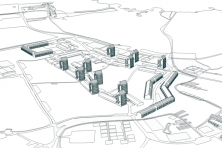Paths
Hammarö (SE) – Winner
TEAM DATA
Team Representative: Federico Colella (IT) – architect; Associate: Hugo Vargas (MX) – architect
via del Quadraro 64, 00174 Roma – Italia
+39 333 851 4953 – federico.colella@hotmail.com – e12-pathsproject.blogspot.it
See the complete listing of portraits here
See the site page here

F. Colella and H. Vargas
INTERVIEW
1. How did you form the team for the competition?
In Nov. 2010 we worked together at TOA (Taller de Operaciones Ambientales) –a design office based in Mexico City–, developing landscape and environmental projects with different budgets and scales. This was a good opportunity to start sharing and discussing some ideas and issues about social architecture and the relationship between nature and city. In 2013 we decided to form a team to participate to Europan 12, with the aim of putting in practice some of ours thoughts and ideas in a real professional challenge.
2. How do you define the main issue of your project, insisting on how you answered on this session main topic: adaptability and urban rhythms?
The project considers re-connection as the most important and sensible tool to generate a new balance in the place. The word suggests the idea of a preexisting link –currently broken– that needs being reactivated. The design concept of “Path” is a physical and strategic configuration of these solutions – a dynamic tool that allows different configurations in space and time supporting adaptability and possibility to change. First of all, the “Path-strategy” improves a re-connection with nature through two different points of view: environment and time. We work with environment generating a new reasonable Habitat connecting future inhabitants with their cultural and natural heritage; and use time to plan a progressive “slow” growth.

3. How did this issue and the questions raised by the site mutation meet?
The “Paths-strategy” allows respecting the existing landscape and buildings, obtaining a new identity for the place.
With the “Urban-Path” we upgrade the existing pathway to transform it into a new urban street: to support this change, we design a progressive and flexible growth through a simple functional and architectonical transformation of the existing pavilions. We add some glass porches and generate a new program; while connecting dwelling towers to the porches we re-shape current buildings and improve the density of the whole area, enhancing urban qualities.
With the “Eco-Path” strategy, we work on the concept of heritage; the project maintains the typical Swedish equilibrium between nature and human presence and defines strategies to preserve and regenerate the existing perennial landscape and to strengthen the system of functional vegetation for sun and snow season. A new pathway connects the restored lagoon landscape with the new urban park and carries water to regenerate the area.
4. Have you already treated this issue previously and could you present some reference projects that inspired yours?
It is very common to treat this issue in Italy and Mexico, trying to use time and heritage like design tools, also in everyday professional activities. In our current academic teaching experiences and investigation works, we have tried to apply these concepts to analyze big scale social housing compounds and environmental planning projects. All the works and life of the American philosopher H. D. Thoreau inspires our last projects, especially the book “Walden” that contains reflections about how to live with a “minimum”, taking advantage of the existing natural resources without wasting. Another inspiring source is the work of the land-artist Hamish Fulton and his walking art performances. All housing projects by Ralph Erskine help us define characters of a modern social Swedish Architecture and the Smithsons’ researches and studies about “Cluster City”, help us improve urban density, starting with the concept of the street.
5. Today –within the era of an economic crisis and sustainability– the urban-architectural project should reconsider its production method in time; how did you integrate this issue in your project?
Like Thoreau we consider Time as an expression of nature and life cycles, and not as an economical parameter. The project does not look for “fast urban planning” or a totally solved masterplan with a new well-defined urban form. To produce an organic and healthy Hammarö community, we need more time and a progressive growth. For an efficient integration of the proposal with social and economical environment, growth should be divided in different phases to generate the opportunity to create an urban development with the logic of a maximum flexibility and a progressive adaption. The duration of every phase should depend on natural rhythms of social and economical growth. In this type of urban planning, design gives more importance to the process and not to the “final architectural form” of the community.
6. Is it the first time you have been awarded a prize at Europan? How could this help you in your professional career?
Yes, this is the first time. Although for Europan 11 our project in Alcorcón (ES) was among the last five preselected project. We hope to take advantage of the prize to promote our research projects on social habitat, landscape and urbanism. Of course we hope to have an opportunity with a future development of the Hammarö “Paths” project. Thanks!